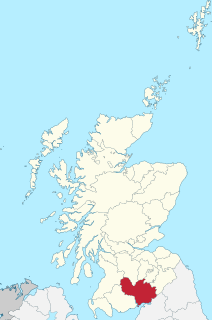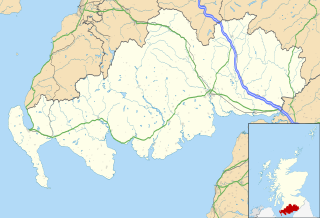Related Research Articles

Dumfries and Galloway is one of 32 unitary council areas of Scotland and is located in the western Southern Uplands. It comprises the historic counties of Dumfriesshire, Kirkcudbrightshire, and Wigtownshire, the latter two of which are collectively known as Galloway. The administrative centre is the town of Dumfries.

Ruthwell is a village and parish on the Solway Firth between Dumfries and Annan in Dumfries and Galloway, Scotland.

Airdrie Savings Bank was a small commercial bank operation in the Lanarkshire area of Scotland. It ran three branches throughout the area, with its head office in Airdrie at the time of the announcement of its closure. Total assets of the bank at 31 October 2013 were £158 million with a reported loss of £267,000. In January 2017, the bank announced it would begin closure proceedings on 28 April of that year.

Dumfriesshire or the County of Dumfries is a historic county, registration county and lieutenancy area of southern Scotland.

The Trustee Savings Bank (TSB) was a British financial institution. Trustee savings banks originated to accept savings deposits from those with moderate means. Their shares were not traded on the stock market but, unlike with mutually held building societies, depositors had no voting rights; nor did they have the power to direct the financial and managerial goals of the organisation. Directors were appointed as trustees on a voluntary basis. The first trustee savings bank was established by Reverend Henry Duncan of Ruthwell in Dumfriesshire for his poorest parishioners in 1810, with its sole purpose being to serve the local people in the community. Between 1970 and 1985, the various trustee savings banks in the United Kingdom were amalgamated into a single institution named TSB Group plc, which was floated on the London Stock Exchange. In 1995, the TSB merged with Lloyds Bank to form Lloyds TSB, at that point the largest bank in the UK by market share and the second-largest by market capitalisation.
A savings and loan association (S&L), or thrift institution, is a financial institution that specializes in accepting savings deposits and making mortgage and other loans. The terms "S&L" or "thrift" are mainly used in the United States; similar institutions in the United Kingdom, Ireland and some Commonwealth countries include building societies and trustee savings banks. They are often mutually held, meaning that the depositors and borrowers are members with voting rights, and have the ability to direct the financial and managerial goals of the organization like the members of a credit union or the policyholders of a mutual insurance company. While it is possible for an S&L to be a joint-stock company, and even publicly traded, in such instances it is no longer truly a mutual association, and depositors and borrowers no longer have membership rights and managerial control. By law, thrifts can have no more than 20 percent of their lending in commercial loans—their focus on mortgage and consumer loans makes them particularly vulnerable to housing downturns such as the deep one the U.S. experienced in 2007.

Henry Duncan FRSE was a Scottish minister, geologist and social reformer. The minister of Ruthwell in Dumfriesshire, he founded the world's first mutual savings bank that would eventually form part of the Trustee Savings Bank. He served as Moderator of the General Assembly of the Church of Scotland in 1839. He was also an author, publisher and philanthropist.
A mutual savings bank is a financial institution chartered by a central or regional government, without capital stock, owned by its members who subscribe to a common fund. From this fund, claims, loans, etc., are paid. Profits after deductions are shared among the members. The institution is intended to provide a safe place for individual members to save and to invest those savings in mortgages, loans, stocks, bonds and other securities and to share in any profits or losses that result. The members own the business.

Annan is a town and former royal burgh in Dumfries and Galloway, south-west Scotland. Historically part of Dumfriesshire, its public buildings include Annan Academy, of which the writer Thomas Carlyle was a pupil, and a Georgian building now known as "Bridge House". The Town Hall was built in Victorian style in 1878, using the local sandstone. Annan also features a Historic Resources Centre. In Port Street, some of the windows remain blocked up to avoid paying the window tax.
The Savings Bank of South Australia was founded in 1848, trading from a single room in Gawler Place, Adelaide. In 1984 it merged with the State Bank of South Australia, with the merged entity taking the latter name. The Bank of South Australia is now a division and a trading name of St.George Bank, which is now a subsidiary of Westpac.
The Cumberland Building Society was established on 16 April 1850 as the Cumberland Co-operative Land and Benefit Building Society. It has its headquarters in Carlisle, Cumbria, England. It is the 10th largest in the United Kingdom based on total assets of £2.5 billion as at 31 March 2018. The first branch was opened 100 miles south of Cumberland in Preston, Lancashire. It is a member of the Building Societies Association.

The Commercial Bank of Scotland Ltd. was a Scottish commercial bank. It was founded in Edinburgh in 1810, and obtained a royal charter in 1831. It grew substantially through the 19th and early 20th centuries, until 1958, when it merged with the National Bank of Scotland to become the National Commercial Bank of Scotland. Ten years later the National Commercial Bank merged with the Royal Bank of Scotland.
Events from the year 1810 in Scotland.
Events from the year 1836 in Scotland.
The Dumfries Courier is a weekly newspaper published in Annan, Scotland. It was founded in 1809 by Rev. Dr Henry Duncan (1774-1846) as The Dumfries and Galloway Courier and is currently published by the DNG Media Group as the Dumfries Courier.
Events from the year 1809 in Scotland.
Robert Halliday Gunning FRSE PRPSE FSA LLD was a Scottish surgeon, entrepreneur and philanthropist. He did much to improve social conditions in Brazil and also became rich there. He endowed numerous prizes and awards including the Gunning Victoria Jubilee Prizes. The University of Edinburgh provides scholarships under the title of Gunning Victoria Jubilee Bursaries. He was a close friend of both Thomas Chalmers and Robert Christison.
Mary Lundie Duncan was a Scottish poet and hymnwriter from Kelso, Scotland.
Formed in 1836, the Edinburgh Savings Bank was successor to the Edinburgh Bank for Savings, which dated back to 1814. Although formed after the Ruthwell Savings Bank, the Edinburgh provided the model for future savings banks. By the end of World War two, it was second in size only to the Glasgow Savings Bank. In 1975, Edinburgh merged with three other Scottish savings banks to form an enlarged South of Scotland TSB.
The Glasgow Savings Bank, formed in 1836, had become the largest savings banks in Scotland by the mid-1850s and the largest in the country by 1870. When the trustee savings banks were reorganised into regional banks in 1975 Glasgow became the core of the West of Scotland TSB.
References
- 1 2 3 H Oliver Horne, A History of Savings Banks, Oxford, 1947
- 1 2 Michael Moss, Henry Duncan and the Savings Bank Movement in the UK, 2011, https://www.wsbi-esbg.org/SiteCollectionDocuments/Moss(Michael).pdf
- 1 2 John L Dinwiddie, The Ruthwell Cross and the Ruthwell Savings Bank, 2nd ed., 1933, Dumfries
- ↑ Natwest Group Archive https://www.natwestgroup.com/heritage/companies/ruthwell-savings-bank.html
- ↑ Collins, Francesca (30 November 2021). "New owners prevent closure of world's first savings bank museum". Museums Journal. Museums Association. Retrieved 3 December 2021.